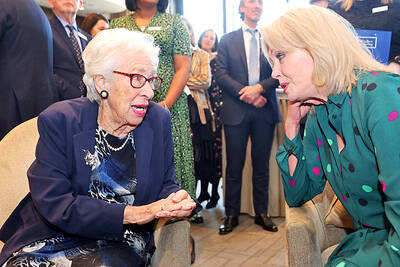The rivalry between Asia’s two biggest countries has extended into outer space.
After India’s landing of its Chandrayaan-3 rover on the moon last month — becoming the first country to put a spacecraft near the lunar south pole and breaking China’s record for the southernmost lunar landing — a top Chinese scientist has said claims about the accomplishment are overstated.
Ouyang Ziyuan (歐陽自遠), lauded as the father of China’s lunar exploration program, told the Chinese-language Science Times newspaper that the Chandrayaan-3 landing site, at 69 degrees south latitude, was nowhere close to the pole, defined as between 88.5 and 90 degrees.
On Earth, 69 degrees south would be within the antarctic circle, but the lunar version of the circle is much closer to the pole.
“It’s wrong,” he said of claims for an Indian polar landing. “The landing site of Chandrayaan-3 is not at the lunar south pole, not in the lunar south pole region, nor is it near the lunar south pole region.”
The Chandrayaan-3 was 619km distant from the polar region, Ouyang said.
India’s space agency did not immediately respond to a request for comment yesterday.
After the Chandrayaan-3 landing, the Chinese Communist Party’s Global Times quoted Pang Zhihao, a Beijing-based senior space expert, as saying that China had much better technology.
China’s space program “has been capable of sending orbiters and landers directly into Earth-Moon transfer orbit since the launch of Chang’e-2 in 2010, a maneuver that India has yet to deliver given the limited capacity of its launch vehicles,” the newspaper said. “The engine that China used is also far more advanced.”
Still, the Chandrayaan-3 went much farther south than any other spacecraft. Russia’s attempt to land a spacecraft near the lunar south pole ended in failure last month when it crashed into the moon.
China’s Chang’e 4, the first to land on the far side of the moon in 2019, touched down 45 degrees south. An uncrewed NASA probe, Surveyor 7, reached the moon at about 41 degrees south in 1968.

Auschwitz survivor Eva Schloss, the stepsister of teenage diarist Anne Frank and a tireless educator about the horrors of the Holocaust, has died. She was 96. The Anne Frank Trust UK, of which Schloss was honorary president, said she died on Saturday in London, where she lived. Britain’s King Charles III said he was “privileged and proud” to have known Schloss, who cofounded the charitable trust to help young people challenge prejudice. “The horrors that she endured as a young woman are impossible to comprehend and yet she devoted the rest of her life to overcoming hatred and prejudice, promoting kindness, courage, understanding

US President Donald Trump on Friday said Washington was “locked and loaded” to respond if Iran killed protesters, prompting Tehran to warn that intervention would destabilize the region. Protesters and security forces on Thursday clashed in several Iranian cities, with six people reported killed, the first deaths since the unrest escalated. Shopkeepers in Tehran on Sunday last week went on strike over high prices and economic stagnation, actions that have since spread into a protest movement that has swept into other parts of the country. If Iran “violently kills peaceful protesters, which is their custom, the United States of America will come to

‘DISRESPECTFUL’: Katie Miller, the wife of Trump’s most influential adviser, drew ire by posting an image of Greenland in the colors of the US flag, captioning it ‘SOON’ US President Donald Trump on Sunday doubled down on his claim that Greenland should become part of the US, despite calls by the Danish prime minister to stop “threatening” the territory. Washington’s military intervention in Venezuela has reignited fears for Greenland, which Trump has repeatedly said he wants to annex, given its strategic location in the arctic. While aboard Air Force One en route to Washington, Trump reiterated the goal. “We need Greenland from the standpoint of national security, and Denmark is not going to be able to do it,” he said in response to a reporter’s question. “We’ll worry about Greenland in

PERILOUS JOURNEY: Over just a matter of days last month, about 1,600 Afghans who were at risk of perishing due to the cold weather were rescued in the mountains Habibullah set off from his home in western Afghanistan determined to find work in Iran, only for the 15-year-old to freeze to death while walking across the mountainous frontier. “He was forced to go, to bring food for the family,” his mother, Mah Jan, said at her mud home in Ghunjan village. “We have no food to eat, we have no clothes to wear. The house in which I live has no electricity, no water. I have no proper window, nothing to burn for heating,” she added, clutching a photograph of her son. Habibullah was one of at least 18 migrants who died